Denmark E-commerce Market Size
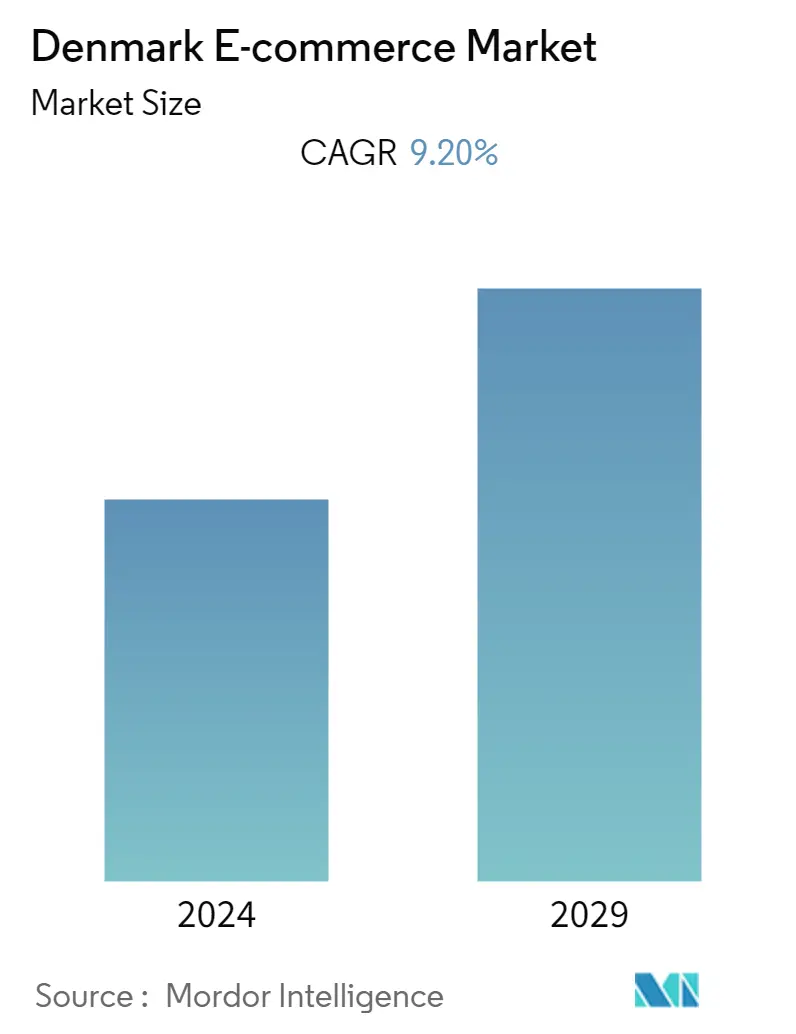
| Study Period | 2019 - 2029 |
| Base Year For Estimation | 2023 |
| Forecast Data Period | 2024 - 2029 |
| Historical Data Period | 2019 - 2022 |
| CAGR | 9.20 % |
| Market Concentration | Low |
Major Players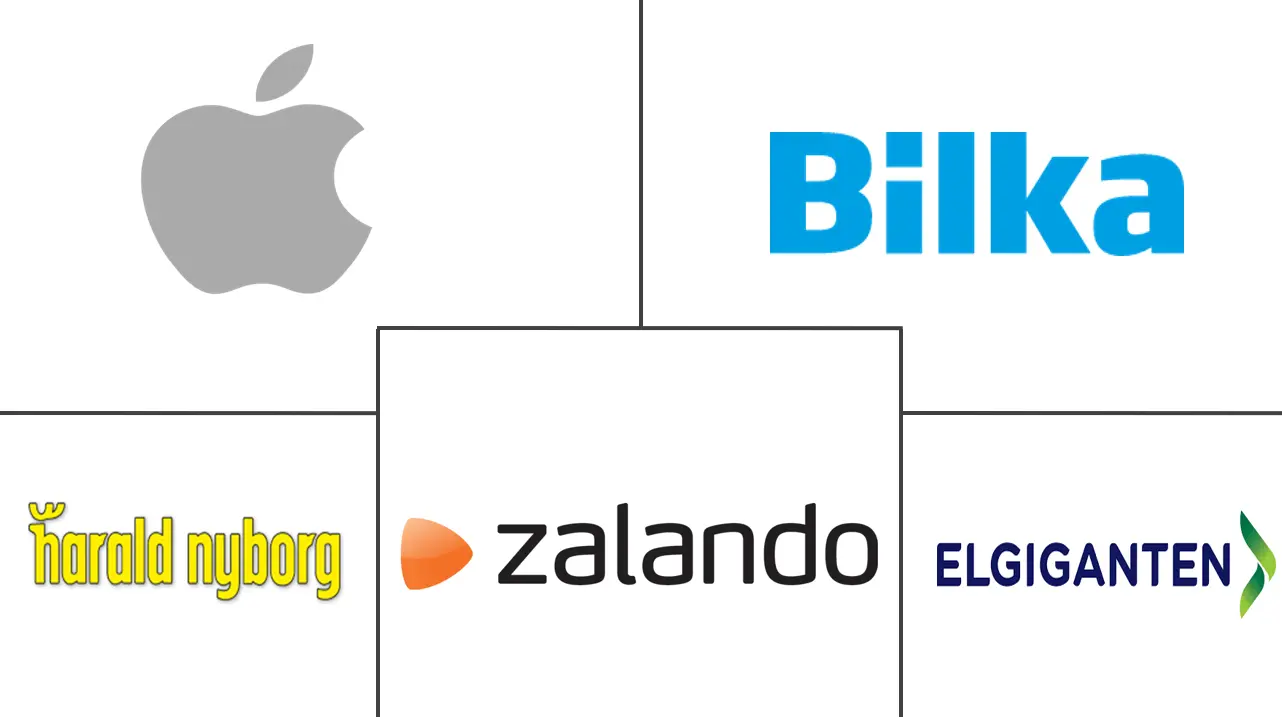
*Disclaimer: Major Players sorted in no particular order |
Denmark E-commerce Market Analysis
The Denmark e-commerce market is expected to register a CAGR of 9.2% during the period 2022-2027. The market is primarily driven by advanced infrastructure, high internet penetration, and a growing number of card-based payment systems.
- Denmark is well-positioned for ongoing e-commerce growth. The region is ranked as one of the top five countries to do business with by the World Bank. International merchants find Danish e-commerce logistics and payments easy to get to grips with and set up their regional businesses. Moreover, cross-border transactions take almost a quarter of total e-commerce in Denmark, making the country an attractive proposition for international merchants.
- To access potential Danish customers via social commerce, many major market players in the region use digital advertising via Facebook. The shoppable platform has the highest reach among social media users in Denmark. As per Hootsuite, Facebook's potential advertising reach percentage of the total population is 61.8%.
- Furthermore, high internet and smartphone penetration in the region is paving the way for the e-commerce market. As per EUROSTAT, 99% of the population has access to the internet in the area.
- Moreover, Black Friday has become a key date in the Danish online shopping calendar. Danes expect good discounts over a week-long sale around the last week of November, with the event dubbed 'Black Week' in the country. Black Friday is a huge revenue opportunity for e-commerce businesses in the region.
- However, increasing fraud in payments for e-commerce or online shopping can hamper the market's growth in the region. As reported by StatBank Denmark, fraud reported in Danish payments cards in e-commerce was 2,969 in Q1 2021, and it increased to 3,492 in Q4 2021. Since most of the population in Denmark uses card payments as a preferred payment method for e-commerce purchases, increasing fraud can limit card usage in e-commerce purchases.
- The COVID-19 pandemic increased online shopping in the region. The increase in sales was present across all categories of e-commerce as consumers stayed at home during the COVID-19 outbreak to help prevent the spread of the COVID-19 virus in Denmark. Moreover, many companies have gone online or enhanced their presence due to Covid-19; this goes for B2B and B2C.
Denmark E-commerce Market Trends
This section covers the major market trends shaping the Denmark E-commerce Market according to our research experts:
Rising Adoption of Card Payments is Expected to Boost the E-commerce Market
- The Danish cards and payments market is well developed and continuously growing, with Danes being prolific users of card payments. Consequently, the share of cash payments within total payment volume has consistently declined. Growing acceptance of payment cards by retailers, e-commerce, and the advent of contactless technology has resulted in accelerated use of electronic payments.
- Online payments in Denmark are card-based and the most preferred online shopping option. Overseas merchants offer comprehensive card payment functionalities to reach as many consumers as possible and gain market share in the region.
- Cards dominate the Danish payment mix. Dankort debit cards co-branded with Visa are the most popular. As per HootSuite, credit card penetration in the region with 44.7%, while debit card penetration is 97.4%, mainly due to Dankort, the domestic bank-based card scheme that is free of charge for users. The card is commonly co-branded with Visa, offering international payment capabilities. The Dankort, the national debit card, is just as popular as cash for retail transactions in Denmark.
- With a 100% banked population and growing adoption of contactless payments, card payments are anticipated to further displace cash transactions over the coming years. Moreover, as per EUROSTAT, the region has a high percentage of users who bought online goods and services, which increased from 82% in 2017 to 91% in 2021. With the increasing convenience of the card payments system, the e-shoppers and e-commerce market is expected to grow further over the forecast period.
- As per Danmarks Nationalbank, the total value of transactions with Danish payments cards in Q1 2021 was 145,929 DKK million. Co-branded Dankort debit card generated the highest value of 100,940 DKK million, followed by the International debit card with 34,515 DKK million. Furthermore, this total value increased to 193,921 DKK million in Q4 2021. The rising adoption of card payments is expected to drive the e-commerce market over the forecast period.
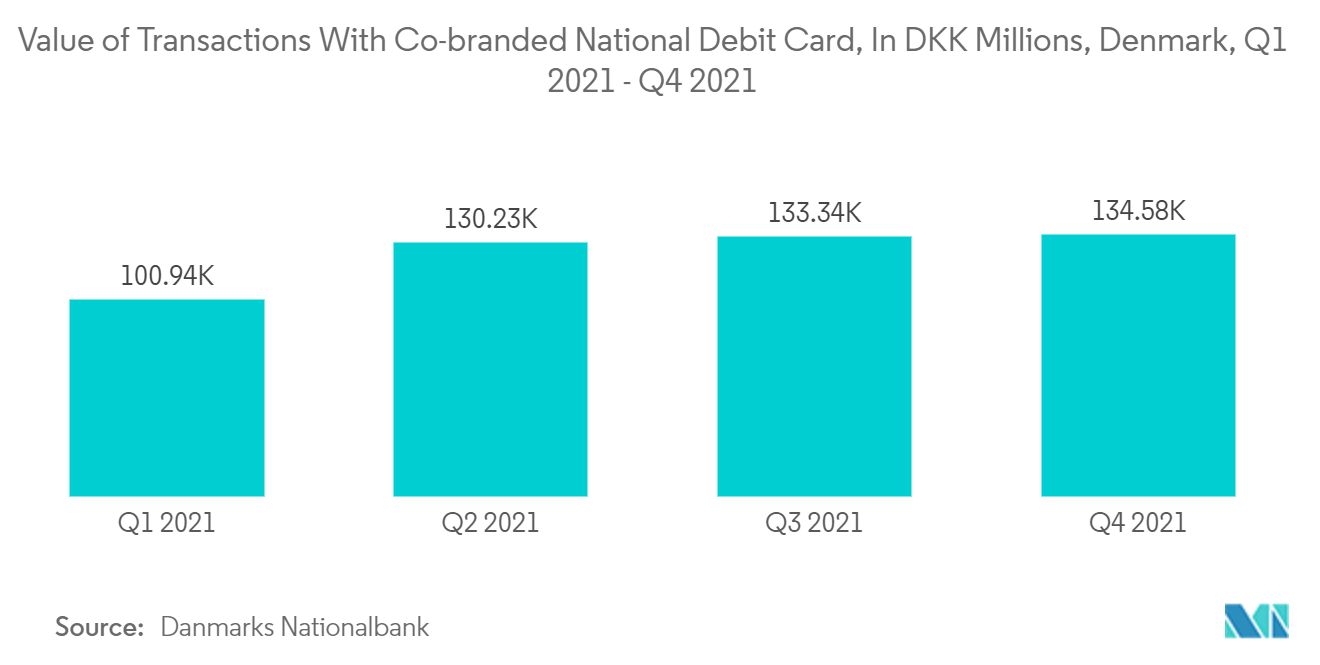
Fashion and Apparel Segment Accounted for the Largest Market Share and is Further Expected to Grow at a Significant CAGR
- The fashion segment is Denmark's most popular e-commerce purchase, with "Clothing, footwear, and jewelry" being the number one category. This applies to both sales revenues and the volume of purchases. This is evident because of the popularity of online fashion retailers in the region, where the most popular websites are fashion retailer companies.
- The German clothing giant Zalando is a famous market participant in Denmark. The company launched its second-hand service Zircle on the Danish market in 2021, which further boosted the sales of clothing and footwear in the region, growing the demand for the fashion and apparel segment in Denmark.
- With the increasing demand for fashion and apparel products, new players are emerging in the region to gain market share. One such player is the online platform The Founded. The Founded was created by the Danish fashion company Bestseller Group. The Founded offers sales of several fashion brands, including clothing from Jack & Jones, Only, and Vero Moda. The Founded replaces the company's former online store Bestseller.com.
- Streaming services and social media platforms like Facebook, Instagram, Spotify, and YouTube are becoming increasingly popular for fashion-related advertisements, mainly aimed toward younger consumers. Since the country has high internet penetration, the advertisement conversion into sales is significantly higher, increasing the sales of fashion-related products in the country.
- As per Statistics Denmark, sales turnover of clothing in Denmark was 2,403 DKK million in the first quarter of 2021, which increased to 5,203 DKK million in the third quarter of 2021. The rise in sales turnover of clothes is further expected to boost the demand for the fashion segment in the region over the forecast period.
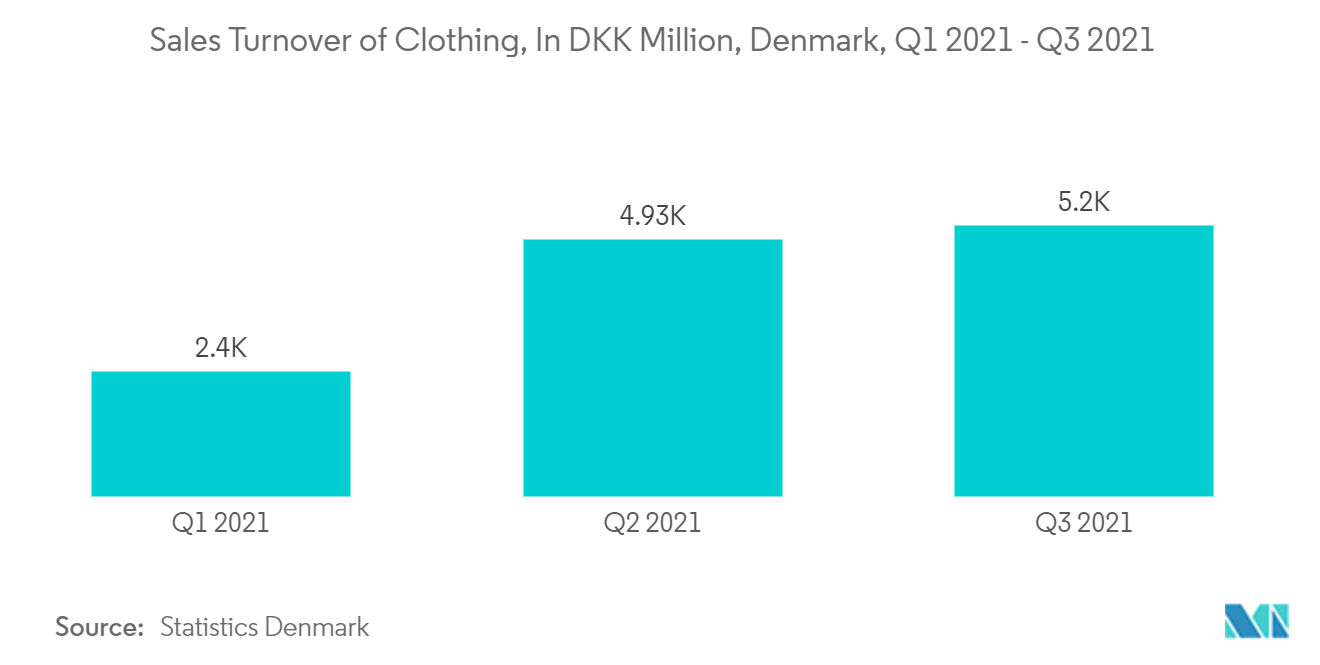
Denmark E-commerce Industry Overview
Denmark's e-commerce market is moderately fragmented in nature. Key major players include Zalando.dk, Elgiganten.dk, Bilka.dk, Apple and Harald Nyborg. These major players account for a considerable percentage of online sales in the region and are actively participating in partnerships and product innovations to gain more market share.
- February 2022 - Denmark's A.P. Moller - Maersk, an integrated logistics company, announced the acquisition of Pilot Freight Services, one of the leading US-based first, middle and last mile, as well as border crossing solutions providers, for USD 1.68 billion to extend its support to customers with around 150 locations in the US, including distribution centers, hubs, and stations.
- October 2021 - Boozt launched a free and seamless option for customers to shop and sell pre-owned fashion and lifestyle products. With the new ReBoozt option, consumers can quickly sell and buy pre-owned Boozt items with a few clicks and no fees. The opportunity to extend the lifetime of fashion and lifestyle items is a natural next step in the company's journey to becoming the leading responsible e-commerce company in Nordics.
Denmark E-commerce Market Leaders
-
Zalando.dk
-
Elgiganten.dk
-
Bilka.dk
-
Apple Inc.
-
Harald Nyborg
*Disclaimer: Major Players sorted in no particular order
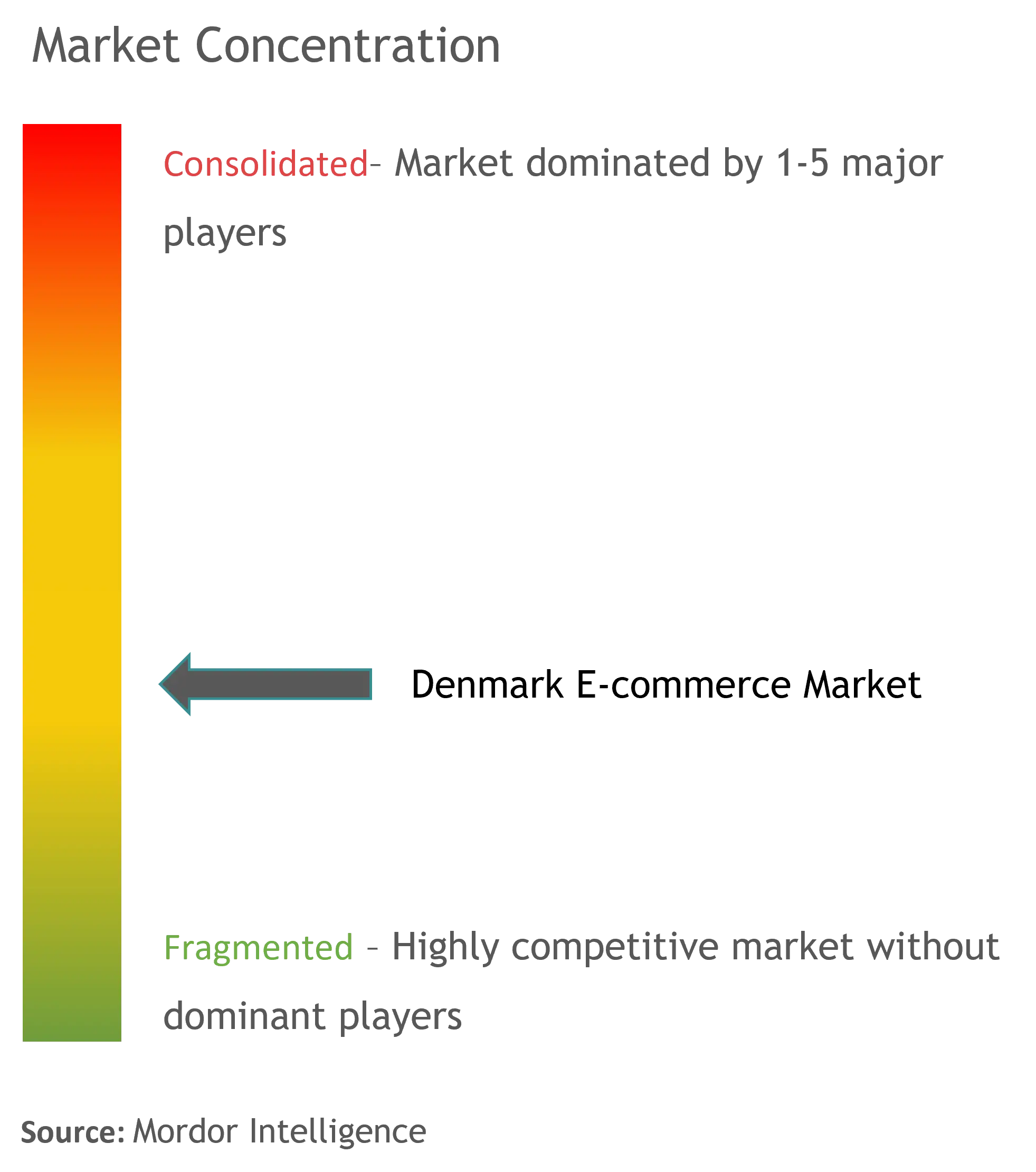
Denmark E-commerce Market News
- January 2022 - Boozt and Rosemunde entered into an agreement where Boozt acquired the remaining 33.3% of the shares of Everyday Luxury Feeling A/S to take full ownership of the company. After successfully integrating Rosemunde into the Boozt group, the parties have agreed to utilize the option to acquire the remaining shares. By taking full ownership, Boozt expects to accelerate the positive development of Rosemunde and further develop the Brand Hub organization to drive a successful expansion of acquired brands like Svea.
- November 2021 - Elgiganten announced to open three new department stores in Jutland and on Funen - more on the way across the country. The new department store concept consists of kitchens, B2B, and Apple shop-in-shops, and the stores will be open in Thisted, Haderslev, and Nyborg.
Denmark E-commerce Market Report - Table of Contents
1. INTRODUCTION
- 1.1 Study Assumptions and Market Defination
- 1.2 Scope of the Study
2. RESEARCH METHODOLOGY
3. EXECUTIVE SUMMARY
4. MARKET INSIGHTS
- 4.1 Market Overview
-
4.2 Industry Attractiveness - Porter's Five Forces Analysis
- 4.2.1 Bargaining Power of Suppliers
- 4.2.2 Bargaining Power of Buyers/Consumers
- 4.2.3 Threat of New Entrants
- 4.2.4 Threat of Substitute Products
- 4.2.5 Intensity of Competitive Rivalry
- 4.3 Key Market Trends and Share of E-commerce of Total Retail Sector
- 4.4 Impact of COVID-19 on the E-commerce Sales
5. MARKET DYNAMICS
-
5.1 Market Drivers
- 5.1.1 Rising Adoption of Card Payments is Expected to Boost the E-commerce Market
- 5.1.2 Rising Online Shopping Penetration
-
5.2 Market Challenges
- 5.2.1 Fraud with Payment Cards in E-commerce
- 5.3 Analysis of Key Demographic Trends and Patterns Related to E-commerce Industry in Denmark (Coverage to Include Population, Internet Penetration, E-commerce Penetration, Age & Income etc.)
- 5.4 Analysis of the Key Modes of Transaction in the E-commerce Industry in Denmark (Coverage to Include Prevalent Modes of Payment Such as Cash, Card, Bank Transfer, Wallets, etc.)
- 5.5 Analysis of Cross-Border E-commerce Industry in Denmark (Current Market Value of Cross-border & Key Trends)
- 5.6 Current Positioning of Denmark in the E-commerce Industry in Europe
6. MARKET SEGMENTATION
-
6.1 By B2C ecommerce
- 6.1.1 Market Size (GMV) for the Period of 2017-2027
- 6.1.2 Market Segmentation - by Application
- 6.1.2.1 Beauty and Personal Care
- 6.1.2.2 Consumer Electronics
- 6.1.2.3 Fashion and Apparel
- 6.1.2.4 Food and Beverages
- 6.1.2.5 Furniture and Home
- 6.1.2.6 Others (Toys, DIY, Media, etc.)
-
6.2 By B2B ecommerce
- 6.2.1 Market Size for the Period of 2017-2027
7. COMPETITIVE LANDSCAPE
-
7.1 Company Profiles
- 7.1.1 Zalando.dk
- 7.1.2 Elgiganten.dk
- 7.1.3 Bilka.dk
- 7.1.4 Apple Inc.
- 7.1.5 Harald Nyborg
- 7.1.6 H&M
- 7.1.7 Boozt
- 7.1.8 Komplett.dk
- 7.1.9 Proshops
- 7.1.10 T. Hansen Gruppen A/S
- *List Not Exhaustive
8. Investment Analysis
9. Future Outlook of the Market
** Subject To AvailablityDenmark E-commerce Industry Segmentation
E-commerce is the purchasing and selling of products and services over the Internet. It is conducted over computers, mobiles, tablets, and other smart devices. There are primarily two types of e-commerce, including Business-to-Consumer (B2C) and Business-to-Business (B2B).
The Denmark E-commerce Market is segmented by B2C eCommerce (Beauty and Personal Care, Consumer Electronics, Fashion and Apparel, Food and Beverage, Furniture and Home), and B2B eCommerce.
| By B2C ecommerce | Market Size (GMV) for the Period of 2017-2027 | |
| Market Segmentation - by Application | Beauty and Personal Care | |
| Consumer Electronics | ||
| Fashion and Apparel | ||
| Food and Beverages | ||
| Furniture and Home | ||
| Others (Toys, DIY, Media, etc.) | ||
| By B2B ecommerce | Market Size for the Period of 2017-2027 |
Denmark E-commerce Market Research FAQs
What is the current Denmark E-commerce Market size?
The Denmark E-commerce Market is projected to register a CAGR of 9.20% during the forecast period (2024-2029)
Who are the key players in Denmark E-commerce Market?
Zalando.dk, Elgiganten.dk, Bilka.dk, Apple Inc. and Harald Nyborg are the major companies operating in the Denmark E-commerce Market.
What years does this Denmark E-commerce Market cover?
The report covers the Denmark E-commerce Market historical market size for years: 2019, 2020, 2021, 2022 and 2023. The report also forecasts the Denmark E-commerce Market size for years: 2024, 2025, 2026, 2027, 2028 and 2029.
Denmark E-commerce Industry Report
Statistics for the 2024 Denmark E-commerce market share, size and revenue growth rate, created by Mordor Intelligence™ Industry Reports. Denmark E-commerce analysis includes a market forecast outlook to 2029 and historical overview. Get a sample of this industry analysis as a free report PDF download.



